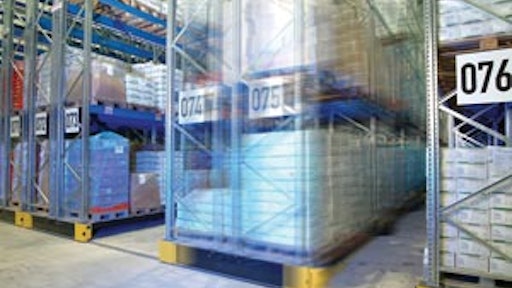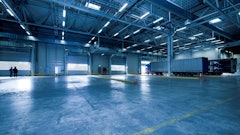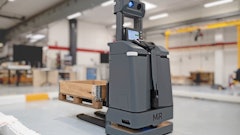
In warehousing, one of the biggest challenges has been increasing the amount of usable storage space without increasing the building's footprint. Many companies have seemingly exhausted all their options. They've started crossdocking some inventory, put storage racks over dock doors and across aisles, cleared out slower-moving SKUs, turned some things over to third-party logistics providers and more, but it's still not enough.
For them, a new mobile racking solution that has proven itself overseas for years is now making its way to North America. These racks promise to increase the amount of usable space in an existing warehouse to about 85 percent.
Mobile racking uses conventional storage racks mounted on trolleys that move from side to side along rails embedded in the floor. The racks are banked together in blocks with no aisles between them. A series of chains and pulleys move the racks to create an aisle only when and where it is needed. Racks move at about 15 feet per minute, meaning that it takes about 30 seconds to open an aisle wide enough for a narrow-aisle forklift to get in and move around to pick or place a pallet.
Rack movement can be directed manually from a push-button control panel or forklift-mounted transmitter or automatically through a computerized processor that can be programmed to interface with the warehouse management system.
"Communication between the racks and the WMS is seamless. The same system that directs a forklift to a specific location within the warehouse sends a signal to the racks to open an aisle," explains Rob Schmit, vice president and managing director of SSI Schaefer's Automation and Systems Division, a mobile racking manufacturer. "While the WMS is telling the driver to go to Aisle 23, the system is opening Aisle 23 so that it is available when he gets there."
Just about any racking system can be converted to a mobile system. "Nine out of 10 standard racks will fit on the system. The mobile racks can hold about 500 metric tons, and they can go 50 or 60 feet high. The only building requirement is that the floor be able to handle them," says Schmit, whose company is based in Germany but has U.S. headquarters in Charlotte, NC.
Mobile rack installation takes about a month to complete. It takes a little more than a week to pour the concrete and install the rails, and another three to four weeks to erect the racks and integrate all the electrical components.
Popular Across The Pond
The technology has been widely used in Europe and Asia for decades—primarily because of the limited availability and high cost of land there. SSI Schaefer has installed about 1,700 mobile racking systems, most of them in Germany, Switzerland and Austria. The fastest growing markets are Asia, the Middle East and eastern Europe; an estimated 80 percent of all the cold stores in these regions are equipped with mobiles.
John Nofsinger, CEO of the Material Handling Industry of America (MHIA), though, expects the use of mobile racking to expand in the United States, due in large part to the European influence. "If you look at overall industry growth and the current levels of globalization and consolidation, you have a lot more companies here with ties to Europe and people there are comfortable using [mobile racking]," he says.
The potential, Nofsinger says, is probably greatest in storage areas where throughput is lower. "I can't see this in a high-volume operation because you would spend half the day just opening and closing aisles," he says. "It's probably best if you go with something like this for your lower-throughput SKUs. I'd still go with static racks for the higher-throughput SKUs."
Currently, only a few North American companies have these systems in place. SSI Schaefer has installed mobile racks at two North American companies, with plans for two other installations in the near future.
Euro-Bake, St. Petersburg, FL, a provider of frozen par-baked and ready-made breads, pretzels and pastries for the foodservice industry, has one of SSI Schaefer's mobile racking systems at the new 56,000-square-foot bakery and frozen storage facility that it opened this month. Twenty-two racks occupy just 13,500 square feet of space.
"With the mobile racks, we were able to add 700 pallet positions in the freezer," says Harty Gerhard, president of Euro-Bake, the U.S. subsidiary of German bakery firm Fricopan Back GmbH. "That gives us enough storage space for an extra 32,000 cases of finished product because we got rid of the aisles between the pallet racks.
"For us, the biggest issue was space, and even if we went with double-deep racking, we wouldn't have gotten as much of a savings because you need about 10 feet of space between each rack for an aisle," Gerhard continues. "We never even looked at static racks. Our parent company in Germany uses nothing but mobile racks and they've had great results."
Two years ago, when St. Anthony Cold Storage, Newfoundland, Canada, began planning for a facility, it included SSI Schaefer's mobile racks in its building plans. By doing so, it was able to scale down the size of the building it would need by 42 percent.
That facility, which opened last year, measures just 45,000 square feet and has 5,184 pallet positions in five-tiered mobile racks that contain eight bays per carriage, three pallets per bay.
"We did it to save space. Because we're in a snow-load zone, there's a limited amount of usable land and we wanted to put as much product in there as possible," says Jon Johansson, president of St. Anthony. "There really was no question. Because land is so very limited, it's the only option we had."
Beyond space savings, mobile racking has brought other benefits to the two companies. Among them is the energy savings that go with the need to cool less area.
"Electricity is our biggest expense after salaries, so we do not want to cool more space than we have to," explains Johansson. St. Anthony's warehouse is kept at minus 25 degrees Celsius.
In addition to cold storage, fishing vessel offloading is another function of the St. Anthony facility. As many as 500-800 pallet loads could come in at one time. The offloading takes only about a half hour to complete because forklifts do not have to travel as far back and forth to stack products in the racks. "With static racks, it could take hours to sort and stack all the pallets around the warehouse," Johansson says.
The same also applies to government and buyer inspections, which take a lot less time because forklift drivers can get to products for sampling a lot more quickly, he says.
And, because they have shorter distances to travel, forklift wear and tear is greatly reduced. "With drive-through racks, we would have needed more forklifts and staff as well," Johansson adds.
"Particularly in a freezer, you can do more in a hostile environment with less people," says MHIA's Nofsinger. "With these racks, you will not need as many workers in that hostile environment."
Sensors and light barriers provide an added layer of safety for mobile racks. When the light beam is interrupted—meaning that there is something in the aisle—the rollers immediately stop moving. Something as small as a cigarette pack placed between the racks is enough to halt the system.
As an added benefit, Johansson says, "it also means that the facility is kept much cleaner because any obstruction stops movement. People can't leave old pallets lying around or the system will not work."
Both St. Anthony and Euro-Bake spent a little more for the mobile racks than they would have for some other racking types, but they say the cost is negligible and will be absorbed quickly by savings elsewhere.
"On capital costs for the building and electrical costs, we are saving money because of the smaller footprint of the building," Johansson explains "Overall, it's a very good solution to our problems and I would not build another facility without it."
Click here to view PDF version Mobile Rack Comparison table.

























